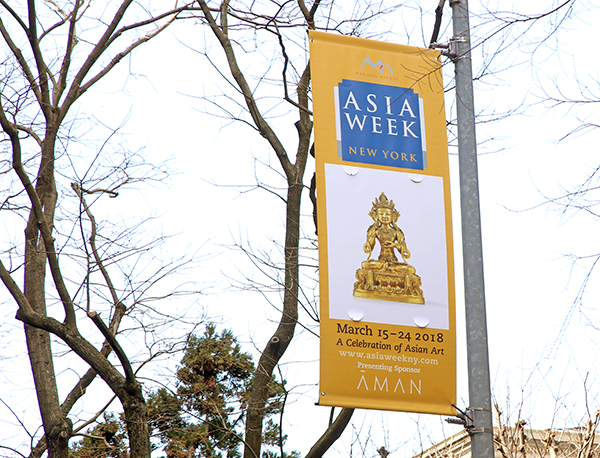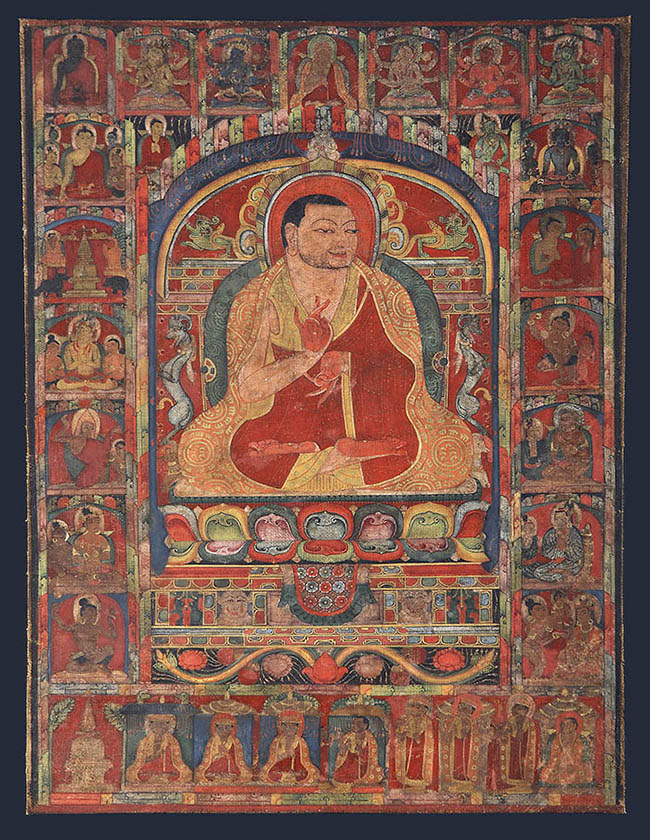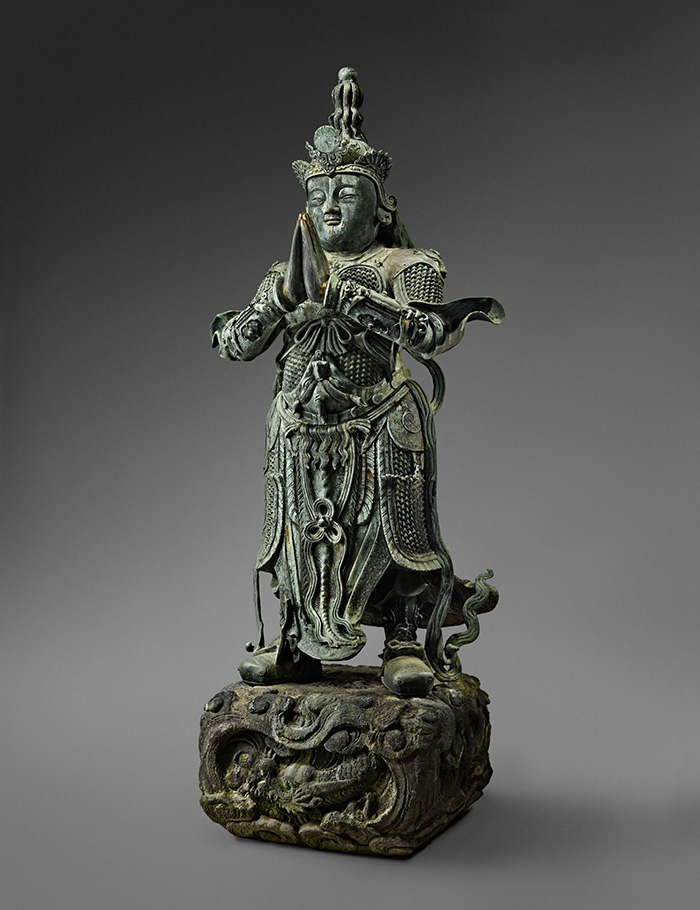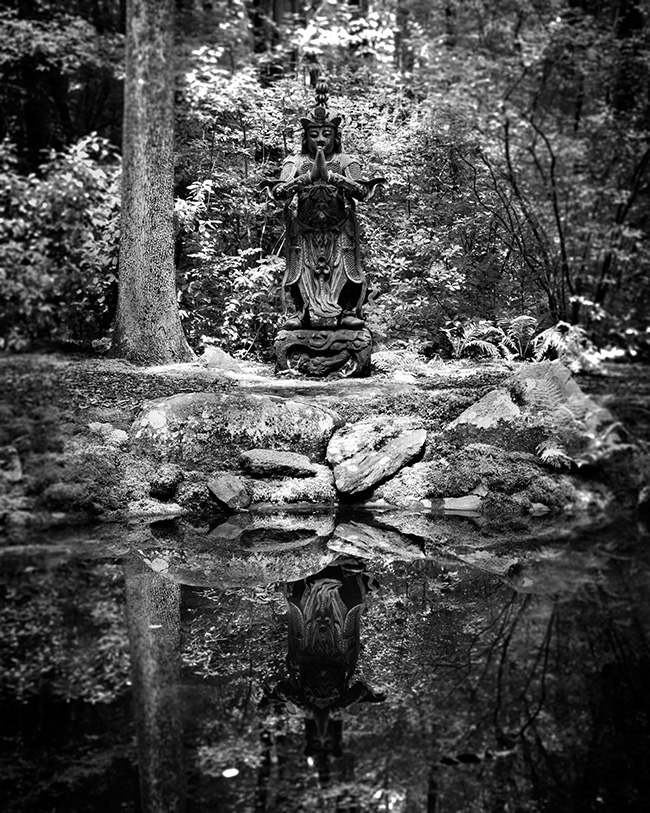
As we look towards Asia Week New York's tenth anniversary in March 2019, we're also taking a look back at the event's most memorable works of art. This is part 4 of a multi-part series in which we are showcasing the most important objects sold by our participants over the last decade. Check back here often or subscribe to our newsletter to stay updated. Below, the stories of four incredible objects:
AN IMPORTANT PORTRAIT FROM CARLO CRISTI

Portrait of Phagmotrupa
Distemper on cotton
Tibet, 13th c.
15 3/8 x 11 5/8 in. (39 x 29,5 cm)
This important tangka shows the portrait of Lama Phagmotrupa (1110-1170 CE), guru of Tashipal, founder of the Taklung monastery (founded in 1180 CE), and one of the main seats of the Kagyu sect. On the reverse, a dedication by Onpo Rimpoche, a successor of Tashipal who was shortly abbot of the Taklung monastery, confirm the date of this tangka to the 13th century. Portraiture of the gurus (masters), produced as realistically as possible but with iconic signs of divinity, coincided with the development of monasticism in Tibet. Phagmotrupa seems to have been one of the first Lamas to be represented on canvas, and there exist only a small number of his portraits. These paintings were made for meditation, to pass on teachings to disciples, and to recognize the historical importance of the master.
The tangka was sold in 2008-2009 to a private European collection.
AN EXQUISITE VASE AT ZETTERQUIST GALLERIES

In the words of dealer Eric Zetterquist:
“In 2012, on the occasion of the 20th anniversary of my gallery, I had the immense pleasure of handling this exquisite and rare Guan-Yao vase. Authentic Guan-Yao (“Official Ware”) is one of the most rare and sought-after of all Chinese ceramics. Produced exclusively for the Imperial Court in the Southern Song Dynasty, adjacent to the Imperial Palace grounds in the Laohudong Kiln Site. Very few of these pieces survived, and most are in public collections. Originally influenced by the Northern Song Dynasty Ru-Ware forms, this piece possesses not only a fine Southern Song form, (often repeated in Longquan celadons), but an ideal Guan-Yao glaze. It is bubbly and slightly opaque with a blue-green hue, and is covered overall with an intentional craquelure that has colored to alternating translucent silver and brownish-gold colors. An identical piece is in the collection of the Victoria and Albert Museum, London.”
A SYMBOLIC CONTEMPORARY DRAWING AT KAI GALLERY

Hui Chi Lee
Untitled, 2011
Graphite & color pencil on paper
28.5 x 36.5 inches
During Asia Week New York 2018 at Kai Gallery, this piece by Taiwanese artist Hui Chi Lee caught the eye of a curator from the Herbert F. Johnson Museum of Art, Cornell University, and the museum subsequently acquired the work. Lee’s name for this series, “Lián: Liàn,” derives from a pair of Chinese homophones, which, depending on the context, mean “to connect” and “to enchain.” To Lee, the seemingly powerless mannequins evoke life in contemporary society. The artist writes, “I am interested in the obscure and anonymous quality of the human form, and I want to guide the viewer to consider the subject matter in a critical, holistic manner… In Chinese tradition, lengthy hair symbolizes longevity. Hair signifies the duration of a life span, an expanse of time of which we are often hardly aware. While we may acknowledge the finitude of life, time is envisioned as somehow endless. Humans favor stability and continuity. Thus, even when one’s comfort and status is threatened or entangled by a chaotic environment, ambivalence seems inevitable. Color is introduced here in a symbolic, metaphorical way. Red symbolizes both a warning and an awakening moment in life.”
A MONUMENTAL GUARDIAN AT GISÈLE CROËS S.A.

Buddhist Guardian Weituo, courtesy of Gisèle Croës S.A.
Ming Dynasty (1368–1644), most likely 15th century
Total height of figure with stand: 93 in (236.22 cm)
Photo by Maggie Nimkin Photography
This monumental bronze, standing over six feet in height even without its stone base is a representation of Weituo, a Buddhist guardian figure whose mythology emerged well before the Ming. Dressed in full armor and wearing the ornate helmet of a Chinese general, Weituo, his hands pressed together in prayer and reverence, stands resolute on a square stone base, faithfully guarding the Buddha, his teachings (the dharma), and Buddhist monasteries, monks, and treasures. This extraordinary, powerfully conceived bronze sculpture of General Wei exquisitely captures in his stance and facial expression his dual role as fierce defender of and unwavering believer in the Buddha, the dharma and the daily life of the Buddhist community or sangha. Appropriately, Weituo was also considered a symbol of determination in spiritual training and practice.

The following is an account of the history of the object by dealer Gisèle Croës:
A few years ago, I was walking through a very large private park in company of the owner, and suddenly we arrived at a beautiful pond where I saw from a distance a magnificent sculpture (above). I had a visual shock and asked about this wonderful piece in such a remote area. After a while, I had the good fortune to acquire it.
With enthusiasm we decided to study the piece and researched its provenance. This piece was purchased in Beijing in 1918 by a prominent Japanese dealer from Kyoto, Yamanaka Sadajirō. More than a hundred years ago, Yamanaka & Company opened its first shop at 20 West 27th Street in New York City. Several decades later, the main overseas branch of Yamanaka & Company in New York occupied a five-story building, on fashionable upper Fifth Avenue, and there were equally prestigious branch offices in Boston, Chicago, London, Peking, Shanghai, Nara and Kyoto. The main Japanese office remained in Osaka. Many people contributed to the success of Yamanaka & Company, but Yamanaka Sadajirō provided the vision that guided the international operation through its formative years.
We asked Professor Annette Juliano from Rutgers University to write an essay on the Weituo. This essay was published in “Gisèle Croës, Matter and Memory Part II,” Brussels, Belgium, 2014, (pages 9–28).
When exhibited in New York at Gagosian Gallery in March 2014, the piece raised an immense interest and was admired by a very large audience of collectors, Institutions and museums. The object was sold in 2014 to a private Chinese collector.
